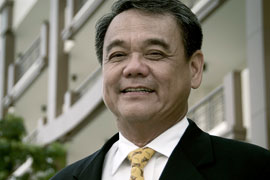
DMCI Holdings president Isidro Consunji:
PHOTO FROM DMCIRESIDENCES.COM
Consunji family-led conglomerate DMCI Holdings plans to enter the cement manufacturing business with a potential $340-million investment to make use of low-grade coal and vast limestone reserves in Antique’s Semirara Island.
In a press chat, DMCI chair and president Isidro Consunji said Semirara Island – where DMCI unit Semirara Mining and Power Corp. was already mining coal – had over one billion metric tons of limestone which could be used for cement production. Initially, he said DMCI could produce 5,000 tons of cement daily.
“You’ll only need two million tons a year so the limestones can last for 500 years if we won’t expand capacity,” Consunji said.
At the same time, he said the conglomerate could make use of low-grade coal from the island – the portion that Semirara could no longer sell – to fuel the cement-making kiln.
“DMCI is doing development work,” Consunji said, adding that a 40-megawatt new power plant fuelled by low-grade coal would likewise be put up to serve the proposed cement plant.
DMCI chief financial officer Herbert Consunji said the group was now studying this plan to debut into the cement business. He said the emerging plan was to put up a cement plant in Semirara Island with an annual capacity of 2.3-2.4 metric tons a year, equivalent to one production line which would likely require around $340 million in investment.
Consunji said, however, that the conglomerate would still have to obtain the necessary regulatory permits and further study this new venture amid dome people’s warning that there may be cement oversupply in the country in three years.
“So this may still be held back but we’re so confident to push this because production cost is low. We can be competitive,” Herbert Consunji said. “We feel we can do it.”
“It can be a new pillar of growth for DMCI,” he said, adding that the group was looking for new areas of growth outside its existing property, construction, water, mining and power businesses.
Herbert Consunji noted that other operating units of DMCI, particularly the property development and construction businesses, were already big users of cement.
At least 10 percent of the output of the proposed cement venture could serve internal requirements, the officials estimated.
Based on industry data, cement consumption in the country has exceeded what can be produced locally.
As of December 2016, the Philippine cement industry had an estimated annual clinker and cement capacity of 20.6 and 28.63 million tons, respectively, based on nameplate capacities of integrated cement manufacturing and grinding plants in the country.
Based on 2014 figures cited by Eagle Cement during its investor briefing, Philippine cement per capita consumption was only 212 kilos, nearly the bottom-dweller in Southeast Asia, beating only Myanmar which consumed 152 kilos of cement per capita. Even Vietnam, Laos and Cambodia had higher per capita consumption of 524, 435 and 241 kilos, respectively.
The country is eventually expected to catch up with regional neighbors in terms of cement demand especially with the Duterte administration’s massive infrastructure-building program.